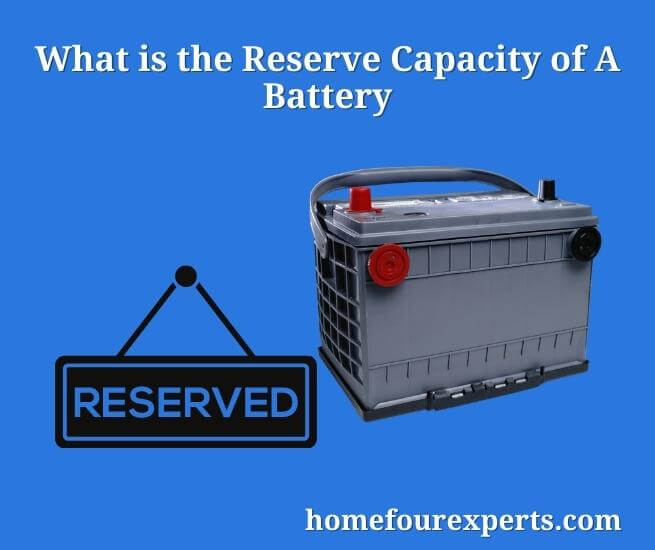Published on: December 8, 2021
Written by Liam Jaxon / Fact-checked by David Rowan
Before purchasing a battery you should have a proper idea about a few important things which have a great influence on battery performance, longevity and maintenance. Though the price is the obvious consideration for purchasing a battery, different people consider different features. Some prefer the brand, some consider warranty and many other things.

But the most important feature or rating you must consider while buying a battery is Reserve Capacity. Because battery performance is definitely a complex matter which includes so many factors and reserve capacity is the most important of them. So by understanding what reserve capacity is, you will be able to make the right decision for purchasing and maintaining a battery.

Reserve Capacity
As discussed earlier, reserve capacity (RC) of a battery is the most important consideration before purchasing a battery. Reserve Capacity of a battery refers to the number of minutes that a fully charged battery at 80-degree Fahrenheit is discharged at 25 amps before the voltage drops to 10.5 volts.
Generally, before power dropping, a battery must be able to discharge at least 25 amps constantly. Because, according to Peukert’s law- as battery current draw increases, the battery capacity decreases. So the higher rating of RC indicates that the battery is able to sustain itself for a long time.
So we can say about Reserve Capacity:
- A battery should be used at least 25 amps before the voltage drops.
- A battery can sustain longer if the reserve capacity rating is high.
Importance of Reserve Capacity
When you start your vehicle, the battery pushes out 25 amperes at 10.5 volts to run the alternator. While running the vehicle the alternator takes over to power the engine. So the battery distributes the same amount of electricity at a constant voltage to provide force to wipers, lights and other accessories.
The alternator usually replaces electricity with a battery put out in a properly conditioned vehicle. The vehicle‘s engine will use electricity if the alternator fails. So when the vehicle operates only on battery power till its discharge is the practical measure of reserve capacity.
In short, sometimes the charging system of your vehicle may fail and in this situation, only the battery is responsible for all types of electrical demands and is able to help you to reach a safe location.
Measuring Reserve Capacity
Measuring reserve capacity becomes more important than measuring Cold Cranking amps (CCA). Because as car models are getting updated, the demand for auxiliary power is also increasing. And for measuring the reserve capacity and cold cranking amps, development of Cadex CA- 12 has completed. By getting this type of information you will be able to determine the time of replacement of the batteries.
Difference Between RC and CCA
You may think that cold cranking amps is enough by itself or RC and CCA may be the same thing. But the fact is CCA and RC both are different. These two are totally different functions of a battery. CCA can help you to understand how much power the battery will deliver in relatively short bursts.
But RC can help you to understand how the battery will deliver energy over the extended period of time. Besides, the higher rated cold cranking amps help to start the engine easily in cold climates. But higher rated RC will supply electric power to the accessories if the alternator fails.
Difference Between AMP Hours and RC
Though AH and RC are related to battery capacity, there’s strong difference between them. Amp hours indicate how much energy is stored in the battery. And the battery can deliver this energy constantly for 20 hours at 80-degree Fahrenheit before falling 10.5 volts. But RC indicates how long the battery can continue to operate the essential accessories of a vehicle if the alternator fails.
How Long a Battery Will last Using Reserve Capacity
To determine the longevity of a battery reserve capacity is a useful specification. But there are limits of using reserve capacity for this reason for two reasons-
- Peukert’s Law, this tells that battery capacity decreases as the current draw increases and vice versa.
- Battery loads may change depending on what device and how they are being used for.
All the mentioned power reserving and operating functions are definitely important for purchasing the right battery. But the most important consideration among these is how long the battery can supply energy to other accessories when the engine is not running, in short, the reserve capacity.
Above all, the most important thing for you to remember is to fully charge the battery when it is deeply discharged.
Relevant Resources:
- What to Look for When Buying a Trolling Motor Battery
- Why Buy a Dewalt Replacement Battery Instead of an Official Battery
About This Writer

Hi, I am responsible for the 'Homeowners Power Solutions' category. My name is Liam Jaxon and a licensed technician with 7 years of experience in vehicle batteries, electrical gadgets, and home appliances. My working experience in different residential & light commercial electrical sectors and the automobile industry helped to acquire vast knowledge in this industry.